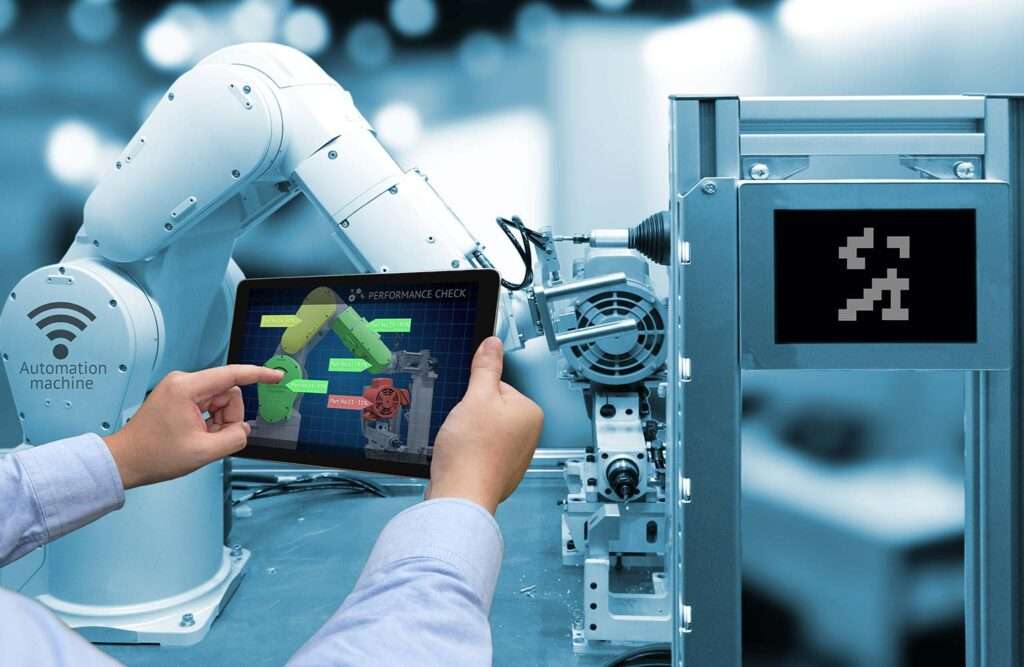Smart Industrial Solutions
"Connecting the physical world to the digital realm, IoT illuminates limitless possibilities, transforming the way we live, work, and thrive."
services we provid
Internet Of Things
The lines dividing the digital spheres and physical continuously get obscured in today’s hyper-connected world,
Solar Pane Monitoring
Using proactively monitoring Solar Panel Monitoring System for their functioning and
Smart Agriculture
The world has come to the conclusion that technology will drive the pace that’s required to keep up with the food demand of such a huge population.
Predictive Maintenance
The predictive maintenance solutions of Technologies use condition monitoring to assess asset performance in real-time.
Digital Twin
Digital Twin Solutions drives the business impact of the Internet of Things (IoT) by offering a powerful way to monitor and control assets and processes.
Waste Management
We use a combination of new strategies and technologies to make sure cities are able to categorically sort,
Internet Of Things
“Technologics is an innovative company specializing in IoT solutions tailored for smart factories. Our range of technologies and services is designed to revolutionize traditional factories into intelligent, interconnected, and data-driven environments. With an in-depth understanding of production processes and an unwavering commitment to innovation, our company consistently excels.
In an increasingly digitized manufacturing landscape, Technologics stands out as a premier supplier of smart Industrial Internet of Things solutions. We empower manufacturers to unlock unparalleled levels of efficiency, productivity, and competitiveness by leveraging cutting-edge technologies and a comprehensive grasp of production processes.”

The Company’s Vision
Our Smart Factory IoT Solutions include:
Industrial Connectivity and Networking: Our technologies offer reliable connectivity solutions, enabling seamless collaboration among the factory’s equipment and machinery. We ensure a secure connection for real-time data transmission across various components of the manufacturing ecosystem using modern networking protocols and technologies such as 5G, Wi-Fi 6, and LoRaWAN.
Sensor Integration and Data Acquisition: By integrating a wide array of sensors throughout the facility, we enable manufacturers to leverage the power of data. These sensors capture critical parameters like temperature, humidity, pressure, vibration, and machine performance data. Real-time monitoring, proactive maintenance, and process improvements are facilitated through data analysis sent to a centralized repository.
Edge Computing and Analytics: We provide manufacturers the capability to process data at the network’s edge, reducing latency and facilitating faster decision-making. Our advanced analytics solutions leverage AI and machine learning algorithms to extract valuable insights from the vast data generated in the smart manufacturing environment. These insights enhance quality assurance and optimize production processes, supporting continuous improvement programs.
Automation and Robotics: We integrate automation and robotics technologies into smart industrial ecosystems to streamline operations and enhance productivity. Our solutions automate repetitive tasks, boost efficiency, and ensure a safer working environment using intelligent robotic systems, autonomous guided vehicles (AGVs), and collaborative robots (cobots). Our smart factory IoT solutions orchestrate the interaction between machines, personnel, and automated systems, enabling a synchronized production environment.
Supply Chain Integration and Optimization: Our smart factory IoT solutions extend beyond the manufacturing floor to encompass the entire supply chain. We provide seamless information flow, real-time inventory management, and streamlined order fulfillment by integrating with suppliers, logistics firms, and customers. This holistic supply chain visibility and optimization enhance operational efficiency, reduce lead times, and increase customer satisfaction.”

FLEET MANAGEMENT
“Technologics’s Fleet Management Solution offers a comprehensive way to track your fleet’s time using Cloud-backed IoT networking. With real-time access to data captured from sensors installed in vehicles, you can ensure compliance with fleet security norms. This includes enhanced vehicle maintenance, fuel management solutions, prompt customer service, driver discipline, and location status.
By implementing our hardware sensors into your fleet, along with the best Fleet Management Software in India, you gain complete control. You bridge compliance by managing data between sensors and systems, receiving insightful reports on vehicle maintenance, driver behavior, fuel efficiencies, faster emergency response, improved customer service, and monitoring your fleet’s operational status.
Technologics offers a flexible, hardware-agnostic IoT architecture for connecting all possible assets—sensors, items, containers, equipment, vehicles, and employees. This enables the tracking and management of the entire logistics infrastructure as a consolidated business unit.
“Scope of Our Fleet Management Solutions:
- Vehicles
- Trucks
- Heavy Equipment
- Cargo Ships
Features of Our Fleet Management Solutions:
- Real-time fleet visibility
- Monitoring the entire fleet
- More accurate ETA predictions
- Driver activity monitoring”
Solar Pane Monitoring

Technologies offers an automated IoT-based solar panel monitoring and troubleshooting system that enables remote monitoring of solar panels from anywhere via the internet. Our solution utilizes various IoT gateways suitable for different needs, based on SoCs like STM32, ESP32, unbox, CC3200, and Silicon Labs to monitor solar panel parameters. The system continuously monitors the solar panel and transmits various parameters to the Cloud using the IoT system. We utilize an IoT platform to transmit solar power parameters to Amazon/Azure cloud/IoT server through a gateway (over Wi-Fi and Ethernet). A powerful web interface allows users to view data in meaningful formats, enabling informed decision-making. Alerts from the panels help address situations such as output falling below specific limits or malfunctioning, ensuring timely fault resolution.
Additionally, we provide Alerts and a monitoring interface on Android/iPhone for distributed Solar Panel Monitoring systems (SPMS). This method utilizes the Bluetooth interface of Android/iPhone for data exchange with the digital hardware of the Solar Unit.
We introduce an instant monitoring solar panel system comprising sensors for current and voltage measurements of each panel source. The measured values are processed by the Microchip and transmitted to a personal computer (PC) via MODBUS to be stored in the database for real-time system observation. The visual interface of the monitoring software can analyze daily, weekly, and monthly values of each measurement separately.”

RFID Solution
From manufacturing to shipping, from the warehouse to the shop floor, encompassing promotions and loyalty cards, we provide an end-to-end Retail Inventory Management Solution. Our approach involves the integration of Radio Frequency Identification (RFID) technology with our software. This combination brings numerous benefits to the retail industry, fostering superior execution, enhanced operational efficiencies, and increased customer satisfaction through comprehensive analytics and inventory accuracy.
Employing high levels of encryption, RFID Tracking, and seamless integration into products, this solution serves effectively for authentication purposes.”
OUR SERVICES BENEFITS
INVENTORY TRACKING
It eliminates human errors in inventory management and tracking, and also audits all inbound and outbound boxes without any error.
INVENTORY RECONCILIATIONAND RESTOCKING
You get accurate information about product location, quantity, and item type. It notifies in case of low stock at store and warehouse through alerts.
AUTOMATED CHECKOUTS
Our RFID Technology registers items in a single scan and helps in faster checkouts. The transaction data is stored to manage returns.
United Nations Food and Agriculture Organizations reports that the volume of food production worldwide will have to increase to nearly 70% in 2050, compared to 2006, to keep up with the explosive global population growth. Smart Agriculture IoT Solutions provide services to increase the production process.
Maximize Production with IoT Based Smart Farming System
The world has come to the conclusion that technology will drive the pace that’s required to keep up with the food demand of such a huge population. Climate Smart Precision Agriculture solution is that technology. Smart Farming IoT Solutions Or Smart Agriculture in short. IoT will play a key role in this, wherewith the help of sensors and data analytics, farmers will gain the priceless data of what the ever-changing climate will bring and will have in hand actionable insights, together with automated irrigation & fertilizer schedule that will push them towards achieving optimal growth from their farms for AI-powered maximum ROI
PROCESS OF SMART AGRICULTURE
CAPTURE DATA
A web of sensors are placed throughout the farm in key locations to gather crucial data, which are streamed to the cloud
DATA ANALYTICS
The data is compared and run through different prediction models to help fashion a strategic roadmap for the farmer to achieve optimal growth.
INFORMED ACTION & PLANNING
The farmer receives these essential actionable insights based on which he can take appropriate actions and make plans that will help him to reach higher productivity and gain.

Predictive Maintenance
- The predictive maintenance solutions of Faststream Technologies use condition monitoring to assess asset performance in real-time. A key element in this process is the Internet of Things (IoT). IoT allows for different assets and systems to connect, work together, share, analyze and make actionable decisions on the data. IoT relies on sensors to capture information, make sense of it and identify any areas that need attention. Some examples of Predictive Maintenance IoT using sensors include vibration analysis, oil analysis, thermal imaging, and equipment observation. Choosing the correct technique for performing condition monitoring is an important consideration that is best done in consultation with equipment manufacturers and our condition monitoring experts.
WHY PREDICTIVE MAINTENANCE ?
- Predictive Maintenance would help reduce downtime by a significant amount.
- It would increase the life cycle of assets by providing pre-determined maintenance alerts to reduce actual asset damage.
- It would help increase machine efficiency by making sure assets are functioning in nominal
conditions. - Resource Management of spare parts/machine parts would become easier with pre-active maintenance alerts.
- Helps improve supply chain by making efficient maintenance checks.
- Proactive maintenance means all maintenance checks happen proactively avoiding redundancies and complete failures.
Predictive Maintenance on Industry 4.0
Overview:
Predictive maintenance for industry 4.0 is a method of preventing asset failure by analyzing production data to identify patterns and predict issues before they happen.
Factory managers and machine operators carried out scheduled maintenance and regularly repaired machine parts to prevent downtime. In addition to consuming unnecessary resources and driving productivity losses, half of all preventive maintenance activities are ineffective.
It is not a surprise, therefore, that predictive maintenance has quickly emerged as a leading Industry 4.0 use case for manufacturers and asset managers. Implementing industrial IoT technologies to monitor asset health, optimize maintenance schedules, and gaining real-time alerts to operational risks, allows manufacturers to lower service costs, maximize uptime, and improve production throughput.
How does Technologies IoT-based predictive maintenance work?
For predictive maintenance to be carried out on an industrial asset, the following base components are used by Technologies:
- Sensors – data-collecting sensors installed in the physical product or machine
- Data communication – the communication system that allows data to securely flow between the monitored asset and the central datastore
- Central data store – the central data hub in which asset data (from OT systems), and business data (from IT systems) are stored, processed, and analyzed; either on-premise or on-cloud
- Predictive analytics – Predictive analytics algorithms are applied to the aggregated data to recognize patterns and generate insights in the form of dashboards and alerts
- Root cause analysis – data analysis tools used by maintenance and process engineers to investigate the insights and determine the corrective action to be performed
The benefits of predictive maintenance with Technologies:
- Manufacturers and their customers get a range of business benefits fromTECHNOLOGICS predictive maintenance. The advantages of our Predictive Maintenance include:
- 1. Reduced maintenance time–Technologies automatic reports for strategic maintenance scheduling and proactive repairs alone reduce maintenance time by 20–50 percent and decrease overall maintenance costs by 5–10 percent. These insights save the manufacturer and their customers time and money.
- 2. Increased efficiency– Our analytics-driven insights improve OEE (overall equipment effectiveness) by reducing unnecessary maintenance, extend asset life and enable root cause analysis of a system to uncover issues ahead of failure.
- 3. New revenue streams- Manufacturers can monetize our industrial predictive maintenance by offering analytics-driven services for their customers, including Predictive Maintenance dashboards, optimized maintenance schedules, or a technician dispatch service before parts need replacement. The ability to provide digital services to customers based on data presents an opportunity for recurring revenue streams and a new growth engine for companies.
- 4. Improved customer satisfaction– Our PDM Solutions send customers automated alerts when parts need to be replaced and suggest timely maintenance services to boost satisfaction and provide a greater measure of predictability.
- 5. Competitive advantage– Faststream Technologies Predictive maintenance strengthens company branding and value to customers, differentiating their products from the competition and allowing them to provide continuous benefit in-market.
- Our Predictive maintenance tools:
- Implementing predictive maintenance requires a baseline of integrated tools.
- Predictive maintenance tools include an industrial IoT platform to model, simulate, test and deploy the predictive maintenance solution.
- The tools include industrial data integration and data analytics algorithms to detect patterns in machine data, and root cause analysis tools for investigating the derived insights and determining the corrective action to be taken.
Difference between preventive and predictive maintenance
- Manufacturers have been carrying out different forms of preventive and predictive maintenance for years. Understanding the difference between them, however, is critical with the emergence of Industry 4.0.
- Preventive maintenance depends on visual inspections, followed by routine asset monitoring that provides limited, objective information about the condition of the machine or system. In this process, manufacturers regularly maintain and repair a machine to prevent failure.
- On the other hand, Predictive Maintenance is data-driven and relies on analytics insights for maintenance and repairs ahead of disruptions in production.
How are Companies using our IoT-based predictive maintenance tools?
- Organizations are implementing predictive maintenance analytics in a range of ways, from targeted solutions for a single machine part, to factory-wide deployments for increasing OEE throughout the production line.
- For machine and parts manufacturers, a relatively common predictive maintenance use case is monitoring and analyzing the condition of a motor to get alerts about its productivity levels, power consumption, health status, and internal wear.
- Another powerful use case of predictive maintenance is minimizing production defects and reducing waste. Often referred to as Quality 4.0, such implementations can predict when the number of defective products is likely to exceed a threshold percentage and provide the root causes for the expected failure.
- Manufacturers are also turning to predictive maintenance for Factory 4.0, or a connected factory, by installing sensors in machines, workstations, and other designated sites such as the HVAC, security cameras, or worker equipment, to predict issues across the factory floor.
The approaches to our IoT predictive maintenance
Rule-based predictive maintenance
- It is also referred to as condition monitoring, rule-based predictive maintenance relies on sensors to continuously collect data about assets, and sends alerts according to predefined rules, including when a specified threshold has been reached. With rule-based analytics, product teams work alongside engineering and customer service departments to establish causes or contributing factors to their machine’s failure. Once common reasons for a product or part failure are established, manufacturers can build a virtual model of their connected system. Here they define product use cases, with “if-this-then-that” rules which describe the behaviors and inter-dependencies between the various IoT system components. For example, if temperature and rotation speed are above certain predefined levels, the system will send an alert to an operator dashboard, to address the issue ahead of failure. These rules provide a level of automated, predictive maintenance, but they are still dependent on a product team’s understanding of what parts or environmental elements require measuring. The condition monitoring dashboards can be integrated with insight from machine learning to provide a visually understandable heatmap of asset conditions in real-time.
- Predictive Maintenance with AI
- Industrial artificial intelligence can be applied to predictive maintenance and many other use cases in the manufacturing industry, and although we are just in the beginning of exploiting this technology, there are already many facilities benefiting from industrial AI.AI is perfectly suited to predictive maintenance. It offers a host of techniques to analyze the huge amounts of data collected from the manufacturing process and deliver actionable insights to reach and sustain manufacturing excellence. These techniques are referred to as Machine Learning algorithms.
- Applying Machine Learning to predict asset failure
- Predictive maintenance with machine learning looks at large sets of historical or test data, combined with tailored machine-learning (ML) algorithms, to run different scenarios and predict what will go wrong, and when.
- Predictive Maintenance ML Algorithms
- Advanced AI algorithms learn a machine’s normal data behavior and use this as a baseline to identify and alert to deviations in real-time. The algorithms required for machine learning must analyze input (historical or a training set of data) and output data (the desired result). A machine monitoring system includes input on a range of factors from temperature to pressure and engine speed. The output is the variable in question – a warning of a future system or part failure. The system will then be able to predict when a breakdown is likely to occur. There are two main approaches to AI and machine learning for predictive analytics – supervised and unsupervised machine learning – each is relevant for a different scenario and depends on the availability of sufficient historical training data and the frequency of asset failure.
Digital Twin

Digital Twin offers a powerful way to monitor and control assets and processes.
Optimize business strategies and factory machine care with a Digital Twin Solutions & Technology, wherein a virtual copy of the entire value chain or a single machine is used to simulate, test, and optimize the processes and functionalities without loss to the business.
Product/Process Virtualization & Control
See a live 3D view of your product whenever you need it, available to you on a CRM for any platform – tablet or desktop, created using CAD or 3Ds Max.
Showcases the relationship between the different components of your business process or device.
Provides better understanding, control with the right context of even the smallest element of any machinery.
Production
Receive actionable insights improved root cause analysis for your entire production line
Improve upon your production capabilities by ascertaining key hurdles and mitigating with suggestions from the AI
Customization
Change any of the parameters of your process and learn instantly of the value or loss it might entail
Make temporary changes to your production line in accordance with custom orders from your customers without causing a ruckus in your budget
AI-powered Recommendations
- The AI, with enough historical data, continues to provide recommendations on enhancing your processes to make them more efficient, shorten time to market, and registering constructive feedback from the end consumers.
Digital Twin in Healthcare
The Digital Twin technology has been widespread in various sectors like Manufacturing, Smart Cities, Retail, Automotive, Oil & Gas, Aerospace, Mining, and Healthcare.
Waste Management

Technologies use a combination of new strategies and technologies to make sure cities are able to categorically sort, recycle, and dispose of their waste in a smooth and efficient manner. From using a combo of weight & distance sensors to determine fill level in trash bins to providing garbage truck drivers optimized route suggestions using predictive analytics; all this would save costs, time, and energy.
TrashFill Sense
Transform a normal trash bin into a smart one. A combo reading from ultrasonic sensors placed on the lid of the trash bin and a weight sensor under the bottom panel is used to get an accurate measurement of the weight of the trash stored.
Get live notifications of filled bins and their locations
Route Optimization
The system determines the best routes for the garbage trucks to take wherein they come across only filled containers.
Save valuable time and fuel.
Data & Analytics
Learn of residents’ waste disposal trends and habits, which can be used to further enhance the operational efficiency of the system. Reducing time-to-pick-up and gain the ability to predict filling trends. This helps minimize bin overfill and maintain healthy conditions around the garbage bins.
Join Us at Technologics!
Unlock the future with us – Contact us now for a world of possibilities!

